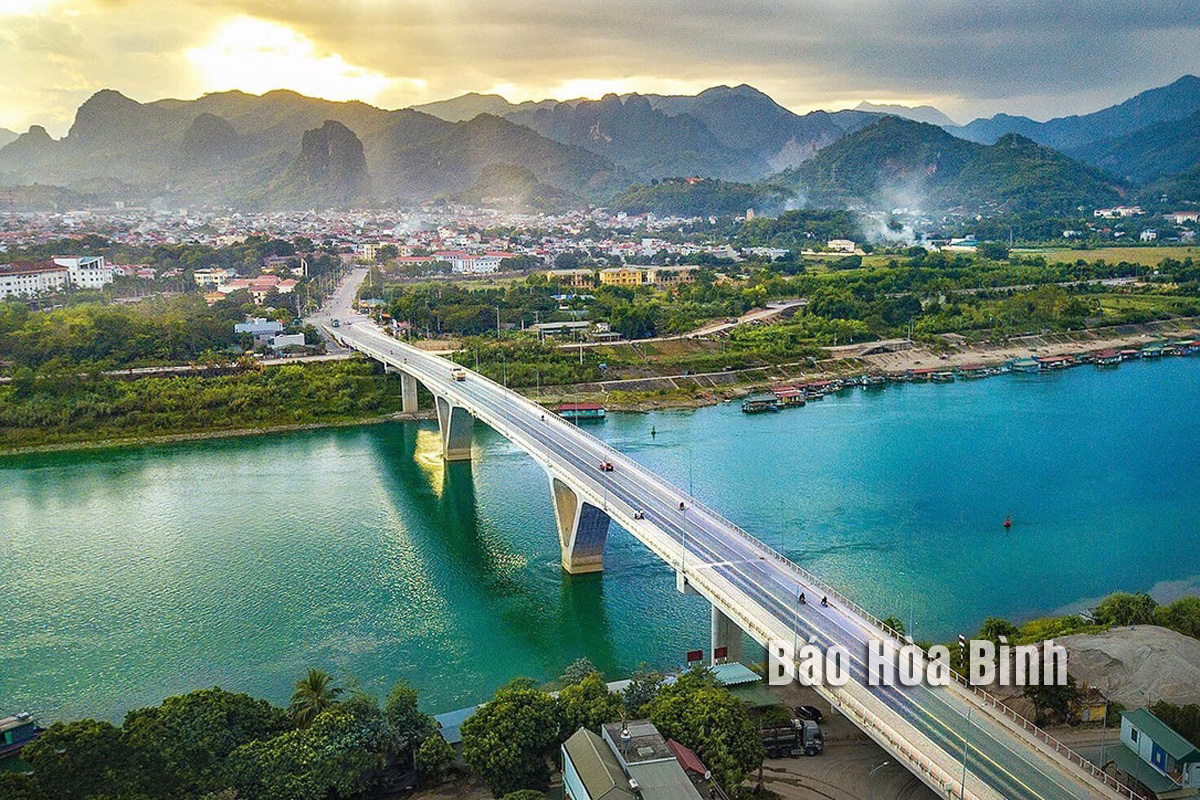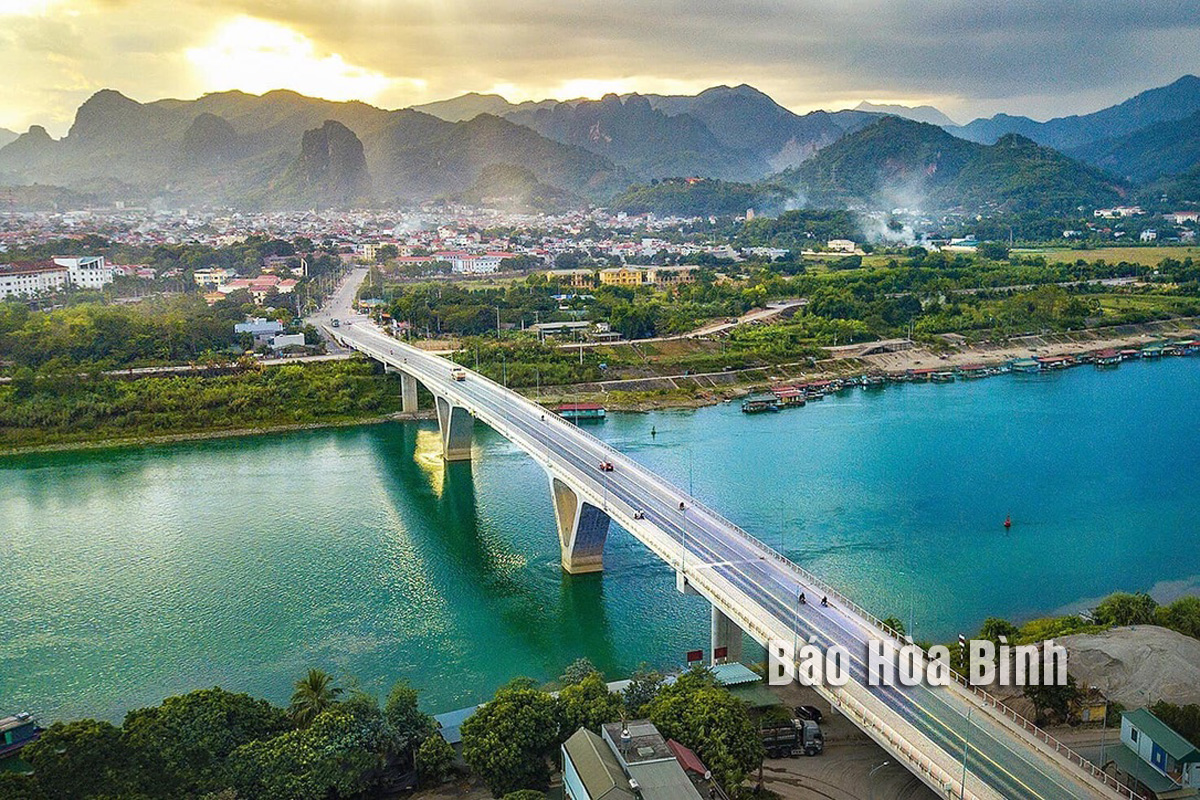
Once barely visible on the northern region’s tourism map, Hoa Binh province welcomed 4.3 million visitors last year, generating a tourism revenue of nearly 4.74 trillion VND (USD), according for 31% of its GDRP. Beyond mere statistics, the milestone demonstrates that tourism and services have become new growth engines for the locality.
The current appearance of Hoa Binh city stands
as a testament to its transformation through economic restructuring.
Policy-driven
transformation
In Giang Mo Village, Binh Thanh commune (Cao
Phong), a homestay was recently inaugurated. Its owner Luong Van Tinh, formerly
a farmer, is rushing off his feet to welcome weekend visitors from Hanoi.
Not far away, the once-quiet road along Hoa Binh Lake now bustles with
tourist vehicles heading to picturesque resorts. A different Hoa Binh is
emerging-more vibrant, more attractive, and ready to become a new tourism hub
in the northern region.
The transformation has been driven by the
Standing Board of the provincial Party Committee’s Resolution No.09-NQ/TU dated
December 31, 2021, which identifies tourism – service an economic pillar with
the ambitious goal of transforming the province into the Northwestern region's
premier destination for resort tourism and cultural experiences.
In Mai Chau district, over 30 households have
shifted from rice cultivation and farming to operating homestays. The
traditional stilt houses maintain their authentic character while offering
modern comforts of electricity, wifi, and comfortable bedding. In the evenings,
tourists immerse themselves in bamboo dances accompanied by vibrant drum and
gong rhythms.
According to Vice Chairman of the district
People’s Committee Hoang Duc Minh, Mai Chau hosted some 210,000 tourist
arrivals, an impressive figure for a mountainous district.
Hoa Binh Lake, once a tranquil expanse
frequented only by fishing boats, now teems with cruise ships, motorboats, and
even kayakers navigating between small islands. Billed as "Ha Long Bay in
the mountains," the lake is gradually establishing itself as a unique
ecological and resort tourism destination in the north. Lake exploration tours
allow tourists to drift across the deep blue waters, fish from boats, and enjoy
freshly grilled fish on islands beside glowing charcoal stoves. Additionally,
numerous lakeside resorts have emerged, transforming the area into a tourism
paradise on the verge of flourishing.
Beyond community tourism, Hoa Binh has quickly
embraced new trends including lakeside resorts and luxury retreats, such as the
Phoenix Golf Course in Luong Son, which attracts visitors from Hanoi and
neighboring provinces. Forest meditation and yoga sessions, natural hot spring
baths, kayaking on the Da River, mountain climbing, and waterfall expeditions
cater to adventure enthusiasts
Tourism has transformed local livelihoods,
helping residents gain stable income while showcasing their ethnic culture to
visitors from everywhere.
Undercurrents
behind growth
If tourism represents the new growth engine,
then commerce and services are the gears operating behind the scenes,
propelling local economy forward with greater momentum. A few years ago, Hoa
Binh residents were familiar only with small traditional markets. Today,
supermarkets and shopping centers appear in the heart of the city and towns,
creating a more modern landscape. The total retail sales of goods and service
revenue in 2024 reached over 74 trillion VND, up 18% against the previous year.
Beyond expanding in scale, the province’s
commerce has established its unique identity through numerous OCOP products.
Cao Phong oranges, forest honey, can wine, and Shan tuyet tea—specialties once
familiar only locally—now appear on shelves in major supermarket chains and
e-commerce platforms like Postmart and Voso, reaching consumers nationwide.
Additionally, transportation and logistics have
boomed, facilitating the flow of goods and tourism development. The Hoa Binh -
Hanoi expressway and key transportation routes have shortened travel times and
significantly reduced logistics costs.
The development of commerce, tourism, and
logistics has generated impressive growth figures and created thousands of new
jobs.
According to Permanent Vice Chairman of the
provincial People’s Committee Nguyen Van Toan, the province’s GRDP per capita
reached 81 million VND in 2024 as compared to 64.7 million VND in 2022.
Services played a substantial role in this growth. If tourism provides the
initial impetus, commerce and services represent persistent currents carrying
this region into a new era. Hoa Binh is advancing along a new path where each
tourist footprint not only leaves an impression but transforms an entire
countryside.
From Mai Chau to Hoa Binh Lake, from Luong Son
to Kim Boi, new economic models have been developed, bringing changes to daily
lives. Hoa Binh is stepping beyond the well-worn path of a purely agricultural
mountainous province. However, challenges are on the horizon for the province
to develop sustainably and ensure no one is left behind during the development
process.
Three years may not be long for such a
transformation, but it's sufficient to affirm that Hoa Binh is no longer a
locality standing outside the major economic arena. The future of the province
will continue to be crafted by the people of this land.
According to data from the Hoa Binh Provincial Party Committee, the industrial production index for the first six months of 2025 is estimated to have increased by 20% compared to the same period last year. This marks the highest year-on-year growth rate for this period since 2020.
In the first six months of 2025, Hoa Binh province’s export turnover was estimated at 1.145 billion USD, marking an 18.11% increase compared to the same period in 2024. Import turnover was estimated at $ 804 million, a 17.15% increase, which helped the province maintain a positive trade balance.
The lives of the ethnic minority farmers in Tan Lac district have gradually improved thanks to the new directions in agricultural production. This is a testament to the collective strength fostered through the professional associations and groups implemented by various levels of the district’s Farmers’ Union.
With the motto the "product quality comes first,” after nearly one year of establishment and operation, Muong village’s Clean Food Agricultural and Commercial Cooperative, located in Cau Hamlet, Hung Son Commune (Kim Boi district), has launched reputable, high-quality agricultural products to the market that are well-received by consumers. The products such as Muong village’s pork sausage, salt-cured chicken, and salt-cured pork hocks have gradually carved out a place in the market and they are on the path to obtaining the OCOP certification.
In the past, the phrase "bumper harvest, rock-bottom prices" was a familiar refrain for Vietnamese farmers engaged in fragmented, small-scale agriculture. But today, a new spirit is emerging across rural areas of Hoa Binh province - one of collaboration, organisation, and collective economic models that provide a stable foundation for production.
Maintaining growing area codes and packing facility codes in accordance with regulations is a mandatory requirement for agricultural products to be eligible for export. Recently, the Department of Agriculture and Environment of Hoa Binh province has intensified technical supervision of designated farming areas and packing facilities to safeguard the "green passport" that enables its products to access international markets.



